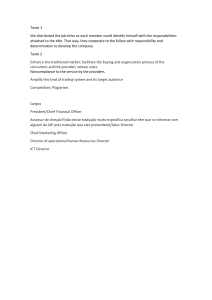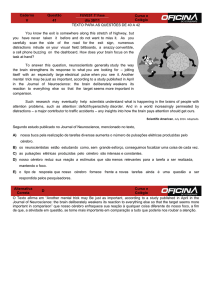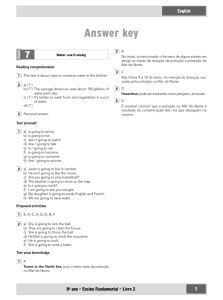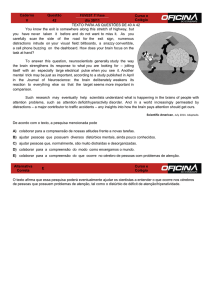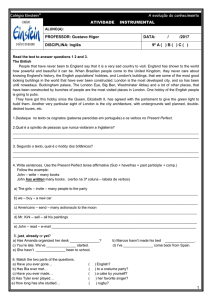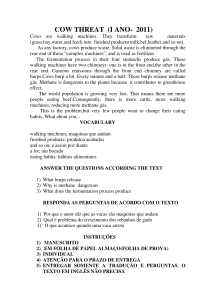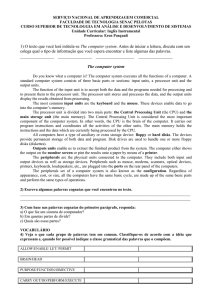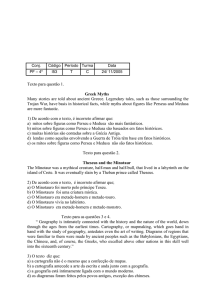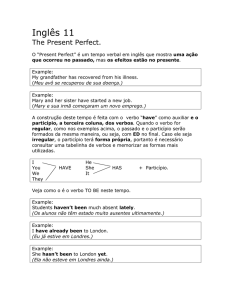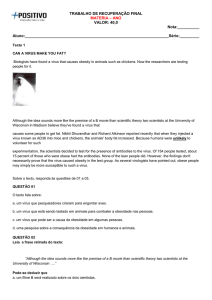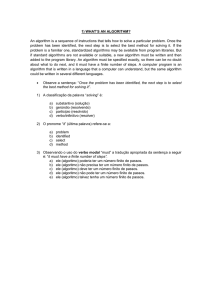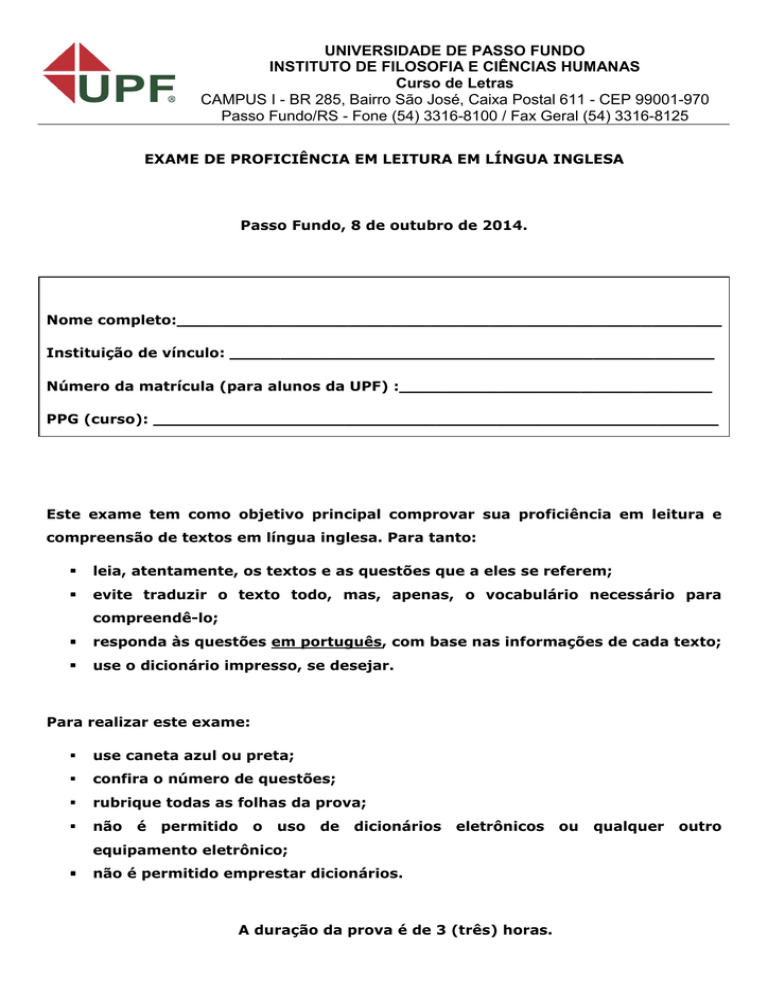
UNIVERSIDADE DE PASSO FUNDO
INSTITUTO DE FILOSOFIA E CIÊNCIAS HUMANAS
Curso de Letras
CAMPUS I - BR 285, Bairro São José, Caixa Postal 611 - CEP 99001-970
Passo Fundo/RS - Fone (54) 3316-8100 / Fax Geral (54) 3316-8125
EXAME DE PROFICIÊNCIA EM LEITURA EM LÍNGUA INGLESA
Passo Fundo, 8 de outubro de 2014.
Nome completo:______________________________________________________
Instituição de vínculo: ________________________________________________
Número da matrícula (para alunos da UPF) :_______________________________
PPG (curso): ________________________________________________________
Este exame tem como objetivo principal comprovar sua proficiência em leitura e
compreensão de textos em língua inglesa. Para tanto:
leia, atentamente, os textos e as questões que a eles se referem;
evite traduzir o texto todo, mas, apenas, o vocabulário necessário para
compreendê-lo;
responda às questões em português, com base nas informações de cada texto;
use o dicionário impresso, se desejar.
Para realizar este exame:
use caneta azul ou preta;
confira o número de questões;
rubrique todas as folhas da prova;
não
é
permitido
o
uso
de
dicionários
eletrônicos
equipamento eletrônico;
não é permitido emprestar dicionários.
A duração da prova é de 3 (três) horas.
ou
qualquer
outro
TEXTO 1
1
Training might teach the brain to prefer healthy food
Sept. 1, 2014 - Courtesy of Tufts University, Health Sciences Campus and World Science staff
It may be possible to train the brain to prefer healthy low-calorie foods over unhealthy higher-calorie
foods, according to new research.
5
“We don’t start out in life loving French fries and hating, for example, whole wheat pasta,” said Susan B.
Roberts, director of the Energy Metabolism Laboratory at the U.S. Agriculture Department’s Human
Nutrition Research Center on Aging. “This conditioning happens over time in response to eating –
repeatedly!—what is out there in the toxic food environment.”
Roberts is senior author of the study, published online Sept. 1 in the journal Nutrition & Diabetes. The
10 findings suggest one could reverse the addictive power of unhealthy food, the investigators said. They
enrolled 13 overweight and obese adults for the study, eight of whom joined a new weight loss program
designed by researchers at Tufts University in Boston. The program included behavior change education
and high-fiber, “low-glycemic” menu plans. Low-glycemic foods are ones that don’t abruptly affect blood
sugar levels.
15 Both groups underwent brain scans at the beginning and end of a six-month period. Among those who
underwent the weight loss program, the brain scans revealed changes in areas of the brain reward center
associated with learning and addiction, the researchers said. After six months, they added, this area
showed more sensitivity to healthy, lower-calorie foods, and less sensitivity to the unhealthy higher-calorie
foods.
20 “The weight loss program is specifically designed to change how people react to different foods, and our
study shows those who participated in it had an increased desire for healthier foods along with a
decreased preference for unhealthy foods, the combined effects of which are probably critical for
sustainable weight control,” said co-author Sai Krupa Das, a scientist in the Energy Metabolism Laboratory
at the center. “To the best of our knowledge this is the first demonstration of this important switch.”
25 “Although other studies have shown that surgical procedures like gastric bypass surgery can decrease how
much people enjoy food generally, this is not very satisfactory because it takes away food enjoyment
generally rather than making healthier foods more appealing,” added co-author Thilo Deckersbach, a
psychologist at Massachusetts General Hospital.
“There is much more research to be done here, involving many more participants, long-term follow-up and
30 investigating more areas of the brain,” Roberts said. “But we are very encouraged that the weight loss
program appears to change what foods are tempting to people.”
Retrieved and adapted from http://www.world-science.net/othernews/140901_brain.htm
AS QUESTÕES 1 A 8 REFEREM-SE AO TEXTO 1.
1. Qual a novidade noticiada pelo Texto 1 e quantos cientistas estão envolvidos diretamente no estudo?
2. O que a Diretora Susan B. Roberts diz sobre a preferência das pessoas por comidas que não são saudáveis?
Por que isso acontece, na opinião dela?
3. A quem ou a que se referem as expressões destacadas no texto?
a) they (linha 10) b) it (linha 21) c) we (linha 30) -
Escreva em português os significados dos grupos nominais abaixo, no contexto do Texto 1:
4. Director of the Energy Metabolism Laboratory -
5. The U.S. Agriculture Department’s Human Nutrition Research Center on Aging -
6. Areas of the brain reward center -
7. The weight loss program -
8. Escreva uma síntese do estudo relatado no Texto 1. Informe: a) o número e a condição física dos participantes;
b) tempo de duração da pesquisa; c) programa do qual eles participaram; d) resultados evidenciados.
TEXTO 2
Battling Ebola: Two doctors for a county of 85,000 people
By Elizabeth Cohen, Senior Medical Correspondent
September 25, 2014
1
Monrovia, Liberia (CNN) -- Meet Dr. Gobee Logan, the county health director for Bomi County in Liberia.
You have now met half the medical team in Bomi County. There are two doctors in the entire county. I
don't mean two doctors to treat Ebola patients but two doctors, period.
Two doctors to take care of Ebola patients, plus the 100 patients in their general hospital, plus the rest
of the county. That's two doctors for about 85,000 people. Logan doesn't complain, even though he's
been working around the clock since June, when the first Ebola case appeared in this agricultural county.
5
He would, however, like an actual Ebola treatment center. He's been taking care of patients in a holding
facility, which has only 12 beds. Sometimes they have nearly double that number, and patients overflow
onto mattresses on the floor. He can't send these patients to real Ebola treatment centers because
they're all full.
10
Logan has been begging the federal government for more than a month for an official Ebola treatment
unit, one with more beds and a quarantine area for people who've come in close contact with Ebola
patients but aren't sick. My team and I saw firsthand Tuesday night just how much he needs a real
hospital.
15
About 7 p.m., an ambulance arrived at Logan's facility in Tubmanburg with five people who, the day
before, had washed the bodies of a mother and daughter who had died of Ebola. After they'd done the
washing, their community kicked them out, Logan told us. Now the five relatives -- three adults, a 13year-old and a 5-year-old -- were in the ambulance in Ebola limbo. They couldn't go back home, and they
couldn't go into the facility because they might get infected.
20
By the light of a single bulb outside the facility, it was decided they'd look for a government building of
some kind where the family could spend the 21-day quarantine. The county health department would
feed them and take care of their needs. But they weren't going to find a place until the morning. The five
relatives would have to spend the night in the ambulance. Logan put in an order for a second ambulance
so they could stretch out and sleep more comfortably.
25
Logan and his staff are doing a heroic job of taking care of Ebola patients under difficult circumstances.
He's strict about infection control -- no health care workers have died on his watch -- and he
resourcefully tries different drugs to save his dying patients.
Here's what I don't understand: With the millions upon millions of dollars spent in West Africa on Ebola,
why doesn't this man get his treatment center? These centers are the single most important way to
prevent the transmission of the disease, since they isolate the infected.
30
Retrieved and adapted from http://edition.cnn.com/2014/09/25/health/reporter-notebook-cohen-ebolath
doctor/index.html. Access on September 28 , 2014.
AS QUESTÕES 9 A 15 REFEREM-SE AO TEXTO 2.
9. Assinale as alternativas que apresentam aspectos denunciados pela autora, ao longo do texto, em relação ao
atendimento aos pacientes infectados pelo vírus Ebola:
a.
(
)
Falta de alimentos.
b. (
)
Falta de infraestrutura.
c. (
)
Falta de remédios.
d. (
)
Falta de direcionamento adequado de recursos financeiros.
10. No contexto relatado pela jornalista, dentre as diferentes necessidades para melhoria no atendimento aos
pacientes, qual é a prioridade do Dr. Logan?
11. Identifique se as informações que seguem são verdadeiras ou falsas, de acordo com o texto:
a. (
b. (
)
)
c. (
)
Dr. Logan trabalha exclusivamente com pacientes contaminados pelo vírus Ebola.
Até o momento, nenhum integrante da equipe de trabalho de Dr. Logan morreu, em consequência do
vírus Ebola.
Os pacientes em quarentena necessitam permanecer em isolamento por 40 dias.
12. Em relação ao episódio presenciado pela equipe de jornalistas, complete as informações:
a) Motivo pelo qual os pacientes foram
enviados ao Dr. Longan
b) Motivo pelo qual os pacientes não
puderam deixar a ambulância durante a
noite
c) Solução indicada para a situação
13. Por que Dr. Logan não consegue enviar seus pacientes aos centros de tratamento de Ebola?
14. Na sentença “… he’s been working around the clock” (linhas 5 e 6), o que a expressão sublinhada permite
inferir?
15. A quem ou a que se referem as expressões destacadas no texto?
a) which (linha 8) b) who (linha 16) c) where (linha 21) -

